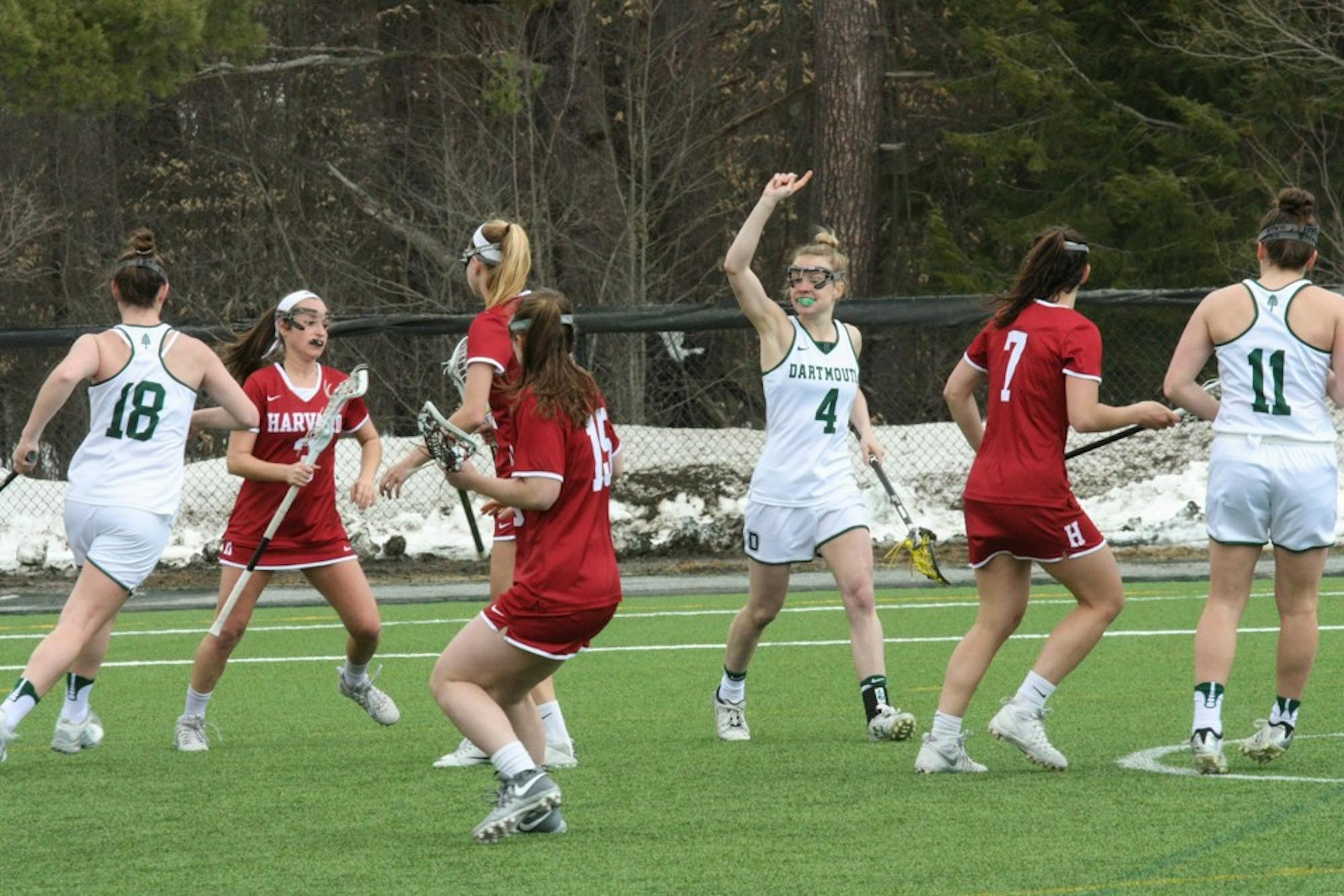There have been a lot more pounding hearts in the Scully-Fahey bleachers during the 2017 women’s lacrosse season. Fans have witnessed a dramatic and dynamic style of play that commands excitement, even when the Big Green doesn’t win.
There’s a simple reason: opposing nets are under heavy fire. Dartmouth has taken an extraordinary 34.44 shots per game this season. To put that number in perspective, the Big Green averaged just 21.6 attempts last season and has never topped 25 per game in a season since statistics became available beginning in 2008. It’s not just Dartmouth that’s gotten faster. Dartmouth’s opponents are also averaging 32.1 shots per game, up from 24.9 shots taken last season.
The easy explanation for this phenomenon would be the impact of the newly-implemented 90-second shot clock, which is the result of a long-awaited rule change made in 2015 by the NCAA Playing Rules Oversight Panel. Now, once a team gains possession, it has 90 seconds to shoot, similar to how basketball teams have an allotted time to shoot the ball during each possession.
The rules of women’s lacrosse make it difficult to gain possession from an opponent, Big Green head coach Danielle Spencer noted. The physical moves that would force a turnover in men’s lacrosse instead earn a penalty in the women’s game. As a result, coaches saw an opportunity they could use to their advantage: when you have a lead, take the ball on offense, and don’t give it back.
“It was a tactic that was within the rules that every single team would use late in the season when they were up in a big conference game,” Spencer said. “They would put their thumb on the ball and slow it down and stall.”
The strategy was legal, effective, shrewd — and incredibly boring for fans.
“No one would enjoy late in the game watching it because no one was shooting anymore,” Spencer said. “So we as coaches had to step outside of our own programs and say, ‘Listen, for the benefit of the sport, we need this game to be exciting, more like basketball, more opportunities for teams to make comebacks late in the game.’”
The NCAA’s stated goal of the rule change was to “[limit] the abuse of clock management and increase the pace of play.”
And it is working.
Nationwide shots-per-game numbers are not available, but Ivy League statistics show the effects of the rule change. Last season, the league averaged 22.95 shots per game. In 2017, that number is up to 29.88.
Spencer has been thrilled with the changes.
“I can’t imagine any coach wishing it went back to the way it was before,” Spencer said. “It allows girls to take more shots and score more goals, and it’s fun. It’s fun to coach, and it’s fun to play with.”
Players agreed.
“I think it’s better that people can’t stall for five minutes, and most of the time we’re not going to be having the ball down [in] the defensive end for five minutes,” goalkeeper Charlotte Wahle ’19 said. “It keeps everyone fresh and makes the game faster.”

This summer, Spencer played with a shot clock in the United Women’s Lacrosse League, where she got a taste of the different style of play. The rule change has made her place more emphasis on transitions. When the team gets the ball upfield quickly after a change of possession, players have more time to make things happen on offense.
“The way I approached it thus far was focusing a lot on our ability to catch and throw really well and limit turnovers that are going to keep the ball down at our defensive end, and make our players be able to move the ball up the field faster and with more confidence,” Spencer said.
Attacker Courtney Weisse ’17 has focused on a similar approach for the Big Green.
“When [the ball is] going into our defensive zone, the mentality for attackers is to slow the ball down as much as possible, to take as much time off of the opponent’s shot clock so that they don’t have as much time when they do get into their attacking zone,” Weisse said. “For us, it’s just a matter of working the defense down and having that awareness of where we are with the shot clock and making sure that we’re getting a shot off. When the shot clock’s running down, we know it’s go time, and it gives people a bit of a push.”
It has also given goalkeepers a bit of a reprieve.
“I try not to be that distracted by looking at it, but it does help that I know that I just need to really focus for a short amount of time, and then I’ll know I’ll get that amount of rest,” Wahle said.
Despite the shot clock’s impact on the game, 90 seconds is still plenty of time.
“It gives you enough time to get a quality shot off and a quality possession,” Weisse said. “I haven’t noticed it come into account as much as I thought it would.”
For Spencer, it’s clear that speed isn’t just a response to the shot clock. It’s one of the fundamentals of her coaching philosophy.
“I think lacrosse is best played when girls can showcase their athleticism on the full field,” she said.
That’s a big part of the reason why Dartmouth now leads the Ivy League in shots per game. Ivy League teams have averaged 6.93 more shots per game this season. But Dartmouth is taking a full 12.8 shots per game more than it did last season. Perhaps 50 percent of the increase can be explained by the shot clock.
“I think it’s more fun for the athletes themselves and for the fans to watch a faster pace of play, and when you do it well, it’s really tough to defend,” Spencer said. “It’s unpredictable, it’s less scripted and you’re always making an opponent’s defense work. Every time you have the ball, they have to defend you, as opposed to just when you run your play.”
For Spencer, the key to effective fast play is to maximize possessions. One way to do this is to generate more possessions. Defensive turnovers are one way to accomplish this, because each turnover cuts short an opponent’s possession and gives Dartmouth its own opportunity. The Big Green rank sixth in the Ivy League in forced turnovers.
Draw controls are another area where a team can gain a possession advantage. And with the help of Spencer, the Big Green has bested its opponents on the draw all season. Dartmouth averages 16.12 draw controls every game, top in the Ivy League by a wide margin.
“That’s really big, instead of a 50-50 ball, giving ourselves an 80 percent chance to get the ball and get another possession,” Spencer said.

Kathryn Giroux ’19, who is tied for sixth in the nation in draw controls per game, has been a big part of Dartmouth’s dominance at the center of the field. At Siena College last Wednesday, the Big Green got 21 draw controls to the Saints’ two. Giroux had a program-record 12.
But fast play is not without its weaknesses. Making more opportunities on the opponent’s side of the field also means giving the ball away more. Dartmouth is last in the Ivy League with 18.22 turnovers per game. Spencer has been working with the team on more efficient stick work, but the turnover total remains a concern.
“Sometimes [fast play] looks really good because it generates shots, and if you shoot well you can have a lot of goals,” Spencer said. “Sometimes it looks really ugly, because if we’re not shooting well and we’re generating a lot of shots, that’s giving the ball back to our opponent a lot more.”
Generating more shots is often different from generating good shots. Dartmouth takes more shots per game than any other Ivy League team, but fewer of those shots find the back of the net than any other team. Dartmouth’s shot percentage of .377 trails the league. So even though it shoots so often, the Big Green is just average in terms of goals per game, with 13.00 on the season.
Spencer acknowledges that a fast pace isn’t always optimal.
“We’ve been talking a lot on our team about having the killer instinct and going out there with confidence, but I think you have to be reflective through that,” she said. “If your shots aren’t falling right away, and you’re getting scored on, then maybe we need to slow it down a bit and work on our possessions — give our defense a rest.”
That’s what Dartmouth looked to do during its Ivy home opener last weekend against No. 5 Princeton University. The Tigers scored the first eight goals in what wound up as a lopsided 18-8 affair. Against Harvard University yesterday, the women took 26 shots to the Crimson’s 33 in a 17-12 loss.
Still, Spencer lets the direction of the game dictate her strategy.
“You come out of the gates, and you attack the other team and you see how it goes,” she said. “If we’re creating opportunities and we’re finishing those opportunities, then let’s keep it rolling. If we’re not, then let’s try to score a different way. Let’s slow it down. Let’s set up a set play that we’ve prepared for that team score that way.”
The women can be assured that they’re playing crowd-pleasing lacrosse. Part of that is the NCAA’s rule change. The rest is the team’s fast philosophy.




